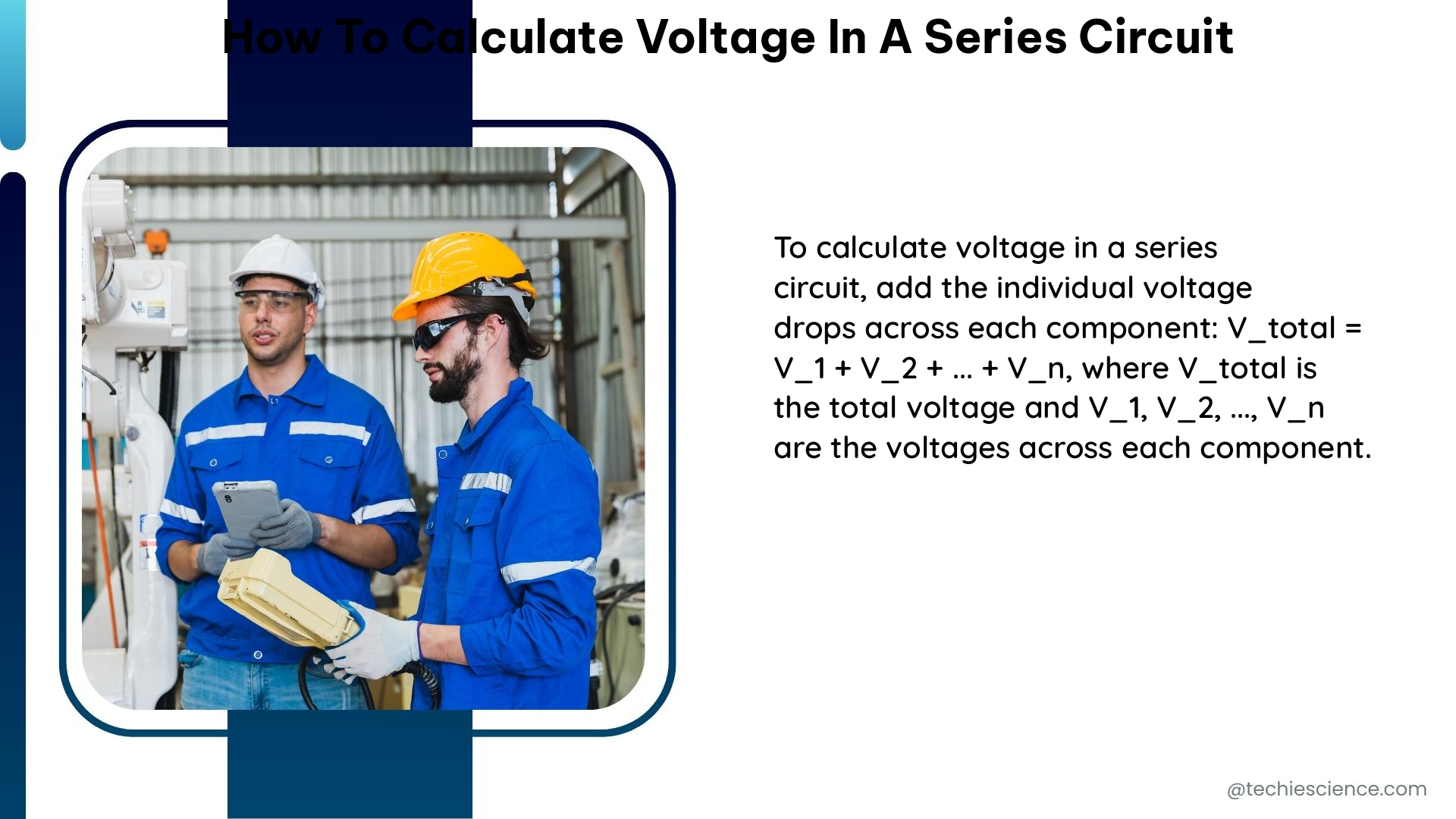In the world of electronics, understanding the behavior of series circuits is crucial for designing and troubleshooting various electronic systems. One of the fundamental aspects of series circuits is the calculation of voltage, which is essential for determining the overall performance and functionality of the circuit. In this comprehensive guide, we will delve into the intricacies of calculating voltage in a series circuit, providing you with a step-by-step approach and practical examples to help you become a proficient electronics enthusiast.
Understanding Series Circuits
A series circuit is a type of electrical circuit where the components are connected end-to-end, forming a single path for the flow of current. In a series circuit, the current flowing through each component is the same, but the voltage drops across each component may vary depending on their resistance.
The formula for calculating the total voltage in a series circuit is:
V = V1 + V2 + V3 + ... + Vn
Where:
– V is the total voltage applied to the circuit
– V1, V2, V3, …, Vn are the voltage drops across each component in the circuit
Applying Ohm’s Law

To calculate the voltage drops across individual components in a series circuit, we can use Ohm’s law, which states that the voltage across a component is equal to the product of the current flowing through it and its resistance. The formula for Ohm’s law is:
V = I × R
Where:
– V is the voltage across the component
– I is the current flowing through the component
– R is the resistance of the component
By applying Ohm’s law, we can determine the voltage drops across each component in the series circuit, which can then be used to calculate the total voltage.
Step-by-Step Approach to Calculating Voltage in a Series Circuit
-
Identify the components: Determine the components in the series circuit, including their resistance values.
-
Determine the current: Identify the current flowing through the series circuit. In a series circuit, the current is the same through all components.
-
Calculate the voltage drops: Using Ohm’s law, calculate the voltage drop across each component in the series circuit:
V1 = I × R1V2 = I × R2V3 = I × R3- …
-
Vn = I × Rn -
Calculate the total voltage: Add up the voltage drops across all the components to find the total voltage in the series circuit:
V = V1 + V2 + V3 + ... + Vn
Example Calculation
Let’s consider a series circuit with the following components:
– Resistor 1 (R1): 10 Ω
– Resistor 2 (R2): 8 Ω
– Resistor 3 (R3): 5 Ω
– Current (I): 2 A
Step 1: Identify the components and their resistance values.
– R1 = 10 Ω
– R2 = 8 Ω
– R3 = 5 Ω
Step 2: Determine the current flowing through the circuit.
– I = 2 A
Step 3: Calculate the voltage drops across each component.
– V1 = I × R1 = 2 A × 10 Ω = 20 V
– V2 = I × R2 = 2 A × 8 Ω = 16 V
– V3 = I × R3 = 2 A × 5 Ω = 10 V
Step 4: Calculate the total voltage in the series circuit.
– V = V1 + V2 + V3 = 20 V + 16 V + 10 V = 46 V
Therefore, the total voltage in the series circuit is 46 V.
Practical Applications and Considerations
The ability to calculate voltage in a series circuit has numerous practical applications, including:
-
Electronic circuit design: Accurately determining the voltage drops across components is crucial for designing and optimizing electronic circuits, ensuring proper functionality and preventing component damage.
-
Troubleshooting: Understanding the voltage distribution in a series circuit can help identify issues, such as faulty components or wiring problems, by comparing the measured voltages with the expected values.
-
Power supply design: In power supply systems, series circuits are often used to distribute and regulate the voltage, and calculating the voltage drops is essential for ensuring the proper operation of the power supply.
-
Battery-powered devices: In devices powered by batteries connected in series, calculating the voltage is crucial for determining the overall battery life and ensuring the proper operation of the device.
It’s important to note that in a series circuit, the current is the same through all components, but the voltage drops across each component may vary depending on their resistance. This property of series circuits is widely used in various electronic applications, from simple circuits to complex power systems.
Conclusion
Mastering the art of calculating voltage in a series circuit is a fundamental skill for any electronics enthusiast or professional. By understanding the underlying principles, applying Ohm’s law, and following the step-by-step approach outlined in this guide, you can confidently tackle a wide range of series circuit problems and design more efficient and reliable electronic systems.
Remember, the key to success in electronics is a deep understanding of the fundamental concepts and the ability to apply them in practical scenarios. Keep practicing, experimenting, and exploring the world of series circuits, and you’ll be well on your way to becoming a true master of voltage calculations.
References
- Voltage in a Series Circuit | Formula & Calculations – Study.com
- Series Circuits and the Application of Ohm’s Law – All About Circuits
- How To Find Voltage In A Series Circuit? – GeeksforGeeks
- Batteries in series and parallel – Primary Connections
- Series Circuits – Physics Classroom
- Voltage and Current in Series Circuits – Khan Academy
- Series Circuits – Electronics Tutorials
- Series Circuits – HyperPhysics
- Series Circuits – Circuit Globe

Hi……I am Kaushikee Banerjee completed my master’s in Electronics and Communications. I am an electronics enthusiast and am currently devoted to the field of Electronics and Communications. My interest lies in exploring cutting-edge technologies. I’m an enthusiastic learner and I tinker around with open-source electronics.